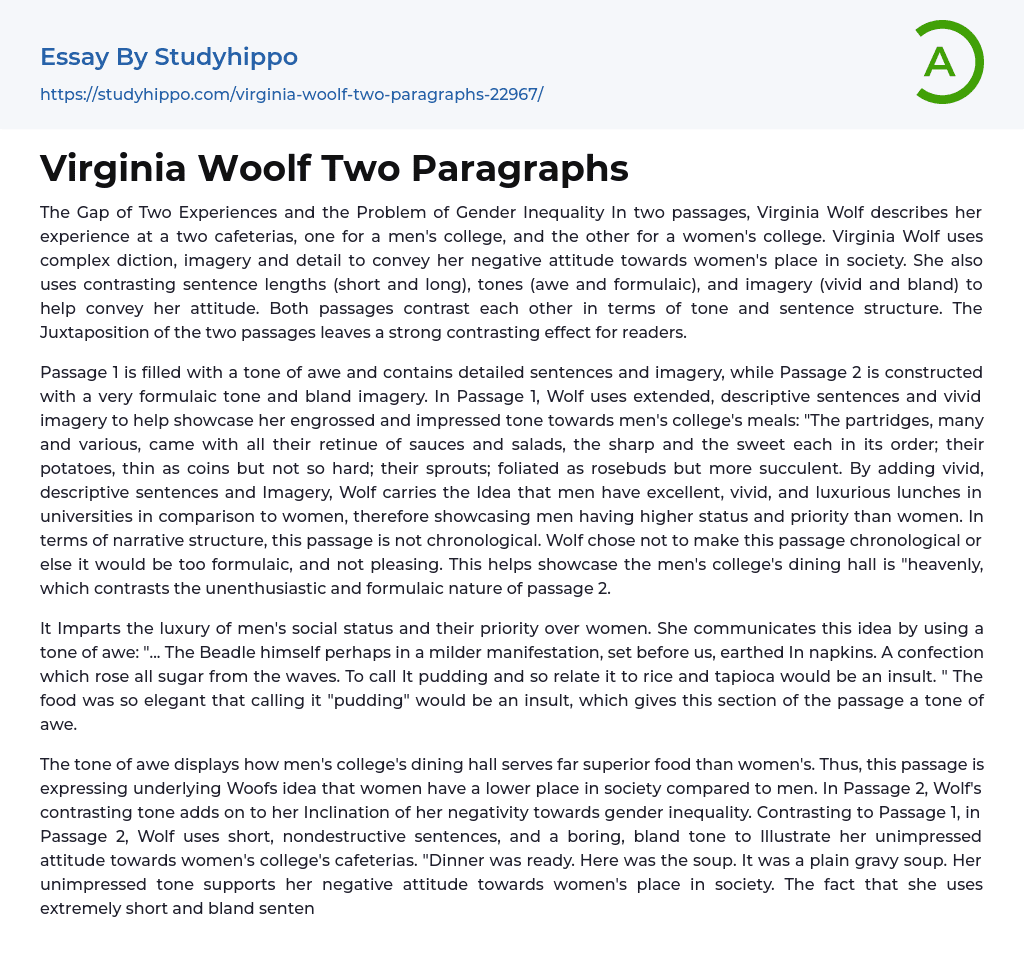The Gap of Two Experiences and the Problem of Gender Inequality In two passages, Virginia Wolf describes her experience at a two cafeterias, one for a men's college, and the other for a women's college. Virginia Wolf uses complex diction, imagery and detail to convey her negative attitude towards women's place in society. She also uses contrasting sentence lengths (short and long), tones (awe and formulaic), and imagery (vivid and bland) to help convey her attitude. Both passages contrast each other in terms of tone and sentence structure. The Juxtaposition of the two passages leaves a strong contrasting effect for readers.
Passage 1 is filled with a tone of awe and contains detailed sentences and imagery, while Passage 2 is constructed with a very formulaic tone and bland imagery. In Passage 1, Wolf uses extended, descr
...iptive sentences and vivid imagery to help showcase her engrossed and impressed tone towards men's college's meals: "The partridges, many and various, came with all their retinue of sauces and salads, the sharp and the sweet each in its order; their potatoes, thin as coins but not so hard; their sprouts; foliated as rosebuds but more succulent. By adding vivid, descriptive sentences and Imagery, Wolf carries the Idea that men have excellent, vivid, and luxurious lunches in universities in comparison to women, therefore showcasing men having higher status and priority than women. In terms of narrative structure, this passage is not chronological. Wolf chose not to make this passage chronological or else it would be too formulaic, and not pleasing. This helps showcase the men's college's dining hall is "heavenly, which contrasts the unenthusiastic and formulaic nature of passag
2.
It Imparts the luxury of men's social status and their priority over women. She communicates this idea by using a tone of awe: "... The Beadle himself perhaps in a milder manifestation, set before us, earthed In napkins. A confection which rose all sugar from the waves. To call It pudding and so relate it to rice and tapioca would be an insult. " The food was so elegant that calling it "pudding" would be an insult, which gives this section of the passage a tone of awe.
The tone of awe displays how men's college's dining hall serves far superior food than women's. Thus, this passage is expressing underlying Woofs idea that women have a lower place in society compared to men. In Passage 2, Wolf's contrasting tone adds on to her Inclination of her negativity towards gender inequality. Contrasting to Passage 1, in Passage 2, Wolf uses short, nondestructive sentences, and a boring, bland tone to Illustrate her unimpressed attitude towards women's college's cafeterias. "Dinner was ready. Here was the soup. It was a plain gravy soup. Her unimpressed tone supports her negative attitude towards women's place in society. The fact that she uses extremely short and bland sentences expresses that women's food are Just not praiseworthy, and that correlates into the social status of women at the time. In fact, the lack of imagery and description allows us to be Immersed Into the black and white setting of this passage. In terms of narrative structure, this passage is in chronological order, and the tone makes the women's college's dining hall sound very monotone and formulaic.
By showing the unfavorable conditions to
the catering in the women's college, it conveys the idea that women have lower priority than men. The elements she provides in this passage proves how she feels towards the inequality of women. The contrasting of both paragraphs effectively convey her negative attitude towards women's place in society. Overall, Wolf incorporates many narrative elements in order to convey and display her unenthusiastic attitude towards women's place in society. Her contrasting of sentence lengths, tones, and imagery is parallel to her experience in the two dining halls.
The two paragraphs' elements contrast each other in a way that allows the reader to see the contrast in not Just the two passages - but rather the experiences of both cafeterias. There was a huge gap in equality between men and women when Virginia Wolf wrote these passages, and she expresses her negative attitude towards it through her experiences. She uses all of the aforementioned narrative elements to contrast these experiences as a metaphor towards how unequal men and women are.
- Food Safety essays
- Food Security essays
- Beverages essays
- Cuisines essays
- Dairy essays
- Desserts essays
- Fast Food essays
- Bread essays
- Meal essays
- Meat essays
- Organic Food essays
- Rice essays
- Sugar essays
- Taste essays
- Beef essays
- Coconut essays
- Crowd essays
- Dinner essays
- Juice essays
- Sainsbury essays
- Cooking essays
- Ginger essays
- Oreo essays
- Drink essays
- Beer essays
- Wine essays
- Coffee essays
- Tea essays
- Cake essays
- Hamburger essays
- Ice Cream essays
- Burger essays
- Pizza essays
- Fruit essays
- Lemon essays
- Food Waste essays
- Favorite Food essays
- Alcoholic essays
- Soft Drinks essays
- Cookie essays
- Starch essays
- Yeast essays
- Cola essays
- Pizza Hut essays
- snack foods essays
- chips essays
- Biscuit essays
- Brewing essays
- Brewery essays
- Feminism essays




